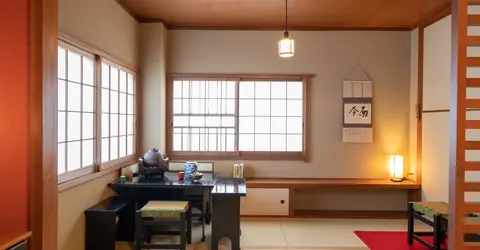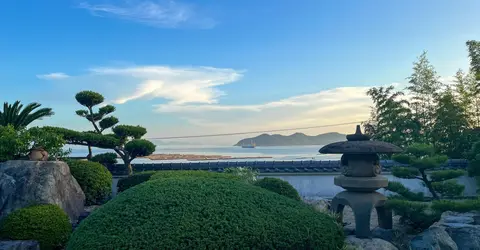Bizen Osafune Japanese Sword Museum
- Published on : 26/08/2017
- by : Japan Experience
- Youtube
The Bizen Osafune Japanese Sword Museum in Okayama displays a collection of samurai swords. The museum also has demonstrations of traditional Japanese sword-making.
Bizen Osafune Japanese Sword Museum 備前長船刀剣博物館, 岡山
If there is one group of people who most signify Japan to people all over the world, that would have to be the samurai, though they only made up about ten percent of the population at most, during their heyday in the Edo Period.

Bizen Osafune Japanese Sword Museum, Okayama
Workshops and galleries of sword-making artisans, Okayama
When Japan began to modernize in the 19th century the samurai were officially disbanded, but samurai values became instilled in the population at large.
War tales involving samurai have a thousand year history in Japan, but samurai stories exploded with post-war TV shows and movies and samurai are now a staple of the "Cool Japan" brand and are used to advertise an astonishing array of products.

Forge and other sword-making workshops, Bizen Osafune Japanese Sword Museum, Okayama
The forge where sword making is still practised, Bizen Osafune Japanese Sword Museum, Okayama
The one thing that is most associated with the samurai is obviously the sword. The cult of the sword really came to the fore during the Edo Period, the time of peace, and historically the sword was actually not so important as a weapon. The vast majority of samurai were killed by projectile weapons - bullets since the 16th century, and arrows before that - but the sword has always had massive symbolic importance in Japan.
The Imperial Regalia, three symbolic objects that signify the ruling family's right to rule includes a sword - the other two being the mirror and the jewel - and the ancient Japanese buried swords as part of religious ritual, the most well known example being the 385 bronze swords unearthed in Shimane's Kojindani, and now on display at the Museum of Ancient Izumo in Izumo, Shimane Prefecture.
The samurai sword took on more symbolic importance after the end of the 16th century when both Oda Nobunaga and then Hideyoshi conducted "sword hunts" and basically disarmed all Japanese other than the samurai.

Sword making workshop at Bizen Osafune Japanese Sword Museum, Okayama
Small shrine to the god of metalworking in the workshops at Bizen Osafune Japanese Sword Museum
Swords in early Japan were made from iron ingots imported from the Korean Peninsula, but soon iron sand was discovered in Japan and this became the preferred source. The myths describing the appearance of what became the Imperial Sword "Kusanagi" suggest that the Izumo region was important in this regard.
The head shrine of the God of metallurgy and forges, Kanayago Kami, is in Izumo, but according to the myth was originally from what is now southern Hyogo Prefecture.
By the Edo Period, sword making was centered on five places called the Gokaden, and of these Bizen, now southern Okayama, was the most important.
Exhibits
Swords are still made in Bizen today, and for those with an interest, the Bizen Osafune Japanese Sword Museum is a must visit. The museum has a massive collection of swords, of all types, from different historical periods, and from all over Japan. The katana is what is now considered the classic samurai sword, but there were a wide variety of styles, shapes, and lengths, and examples of many are on display. Changing thematic exhibitions cycle through the vast collection.
Unfortunately English information is very limited, but with two weeks advance notice the museum will arrange for a free English speaking guide to take you around. Perhaps even more interesting than the museum itself is the group of buildings located right next door.
These are various workshops, including a forge, where swords are still made today. Open to the public, here is a chance to see all the traditional arts and crafts that go into making what many people consider the best swords in the world.
There are some artisans working here most days, blade polishers, engravers, handle and scabbard makers etc. but on two Sundays a month the forge is fired up and visitors can see the steel being taken from its original raw state up to where the sword itself begins to take shape.
It is also possible to take part in a hands-on workshop making your own paper knife. There can be few opportunities to be able to see first-hand all of the different processes and skills that go into the making of a Japanese sword, and so it is obviously worth the effort to make a visit here.
Bizen Osafune Japanese Sword Museum
966 Osafunecho Osafune,
Setouchi-shi, Okayama 701-4271
Tel: 0869-66-7767
Open from 9am-5pm. Closed Mondays, or the next day if a Monday is a National Holiday.
Museum entry is 500 yen. The workshops and shops are free.
The museum is located a bit less than 2km from Kagato Station on the JR Ako Line.
For those with an interest in samurai swords, also in Okayama, on Omishima Island, is the museum of Oyamazumi Shrine, which has the largest collection of samurai swords and armour that are registered as National Treasures.
Access - how to get to Okayama
Rail
Okayama Station is served by the Sanyo Shinkansen line to Osaka (45 minutes), Tokyo (4 hours), Kyoto (1 hour 10 minutes), Nagoya and Fukuoka/Hakata (2 hours). The JR Hakubi Line connects Okayama and Yonago on the Japan Sea coast in Tottori Prefecture.
Bus
Okayama Station is a highway bus terminus for buses to various destinations in the Chugoku region. and beyond. There are long-distance buses to Tokyo (Tokyo Station, Shinjuku Bus Station, Hamamatsucho), Kansai International Airport (KIX), Fukuoka, Hiroshima, Kobe, Kochi, Kyoto Station, Osaka, Nagoya Station, Nagasaki (with a change in Fukuoka), Matsue, Matsuyama, Izumo, Tokushima and Yonago.
Local buses also radiate out from Okayama Station.
Ferry
There are ferry and services to Shikoku and islands in the Inland Sea including Shodoshima from Shin-Okayama Port, 10km south of downtown with buses from Tenmaya Bus Center.















